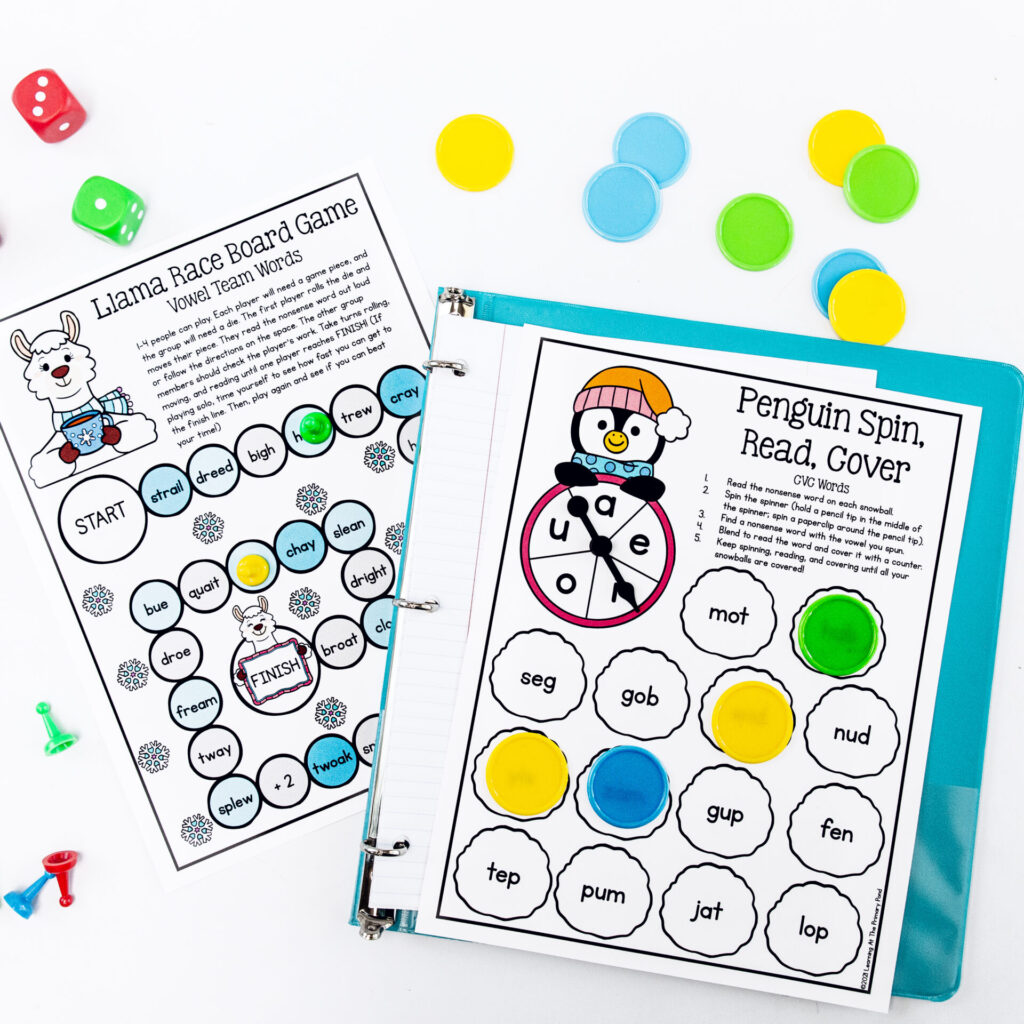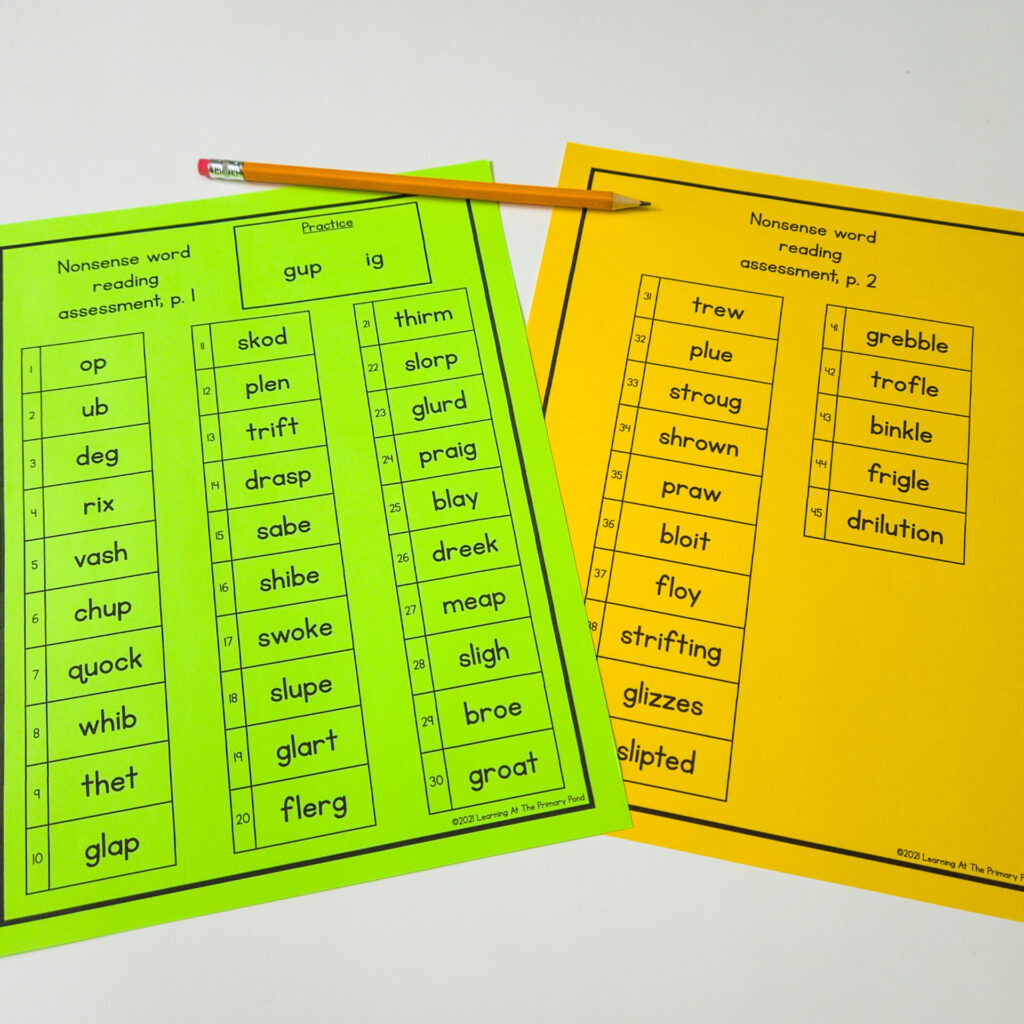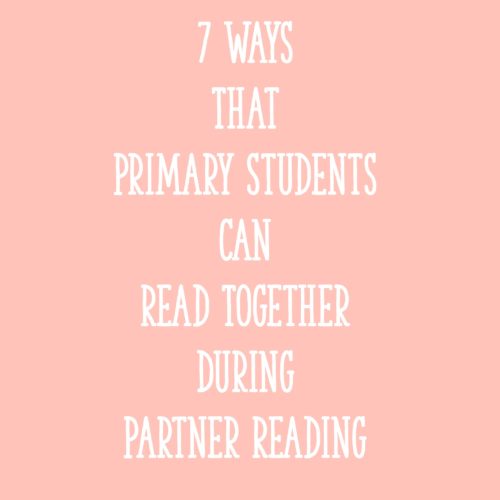If you haven’t heard the term “nonsense words” used in the context of phonics instruction, or if you’re unsure how (or why) to have your students practice them, you’re in the right place! Nonsense words can be such a useful tool for any students learning phonics skills or in need of a refresher. Adding in a couple of nonsense words to read during your phonics routine is a great idea!
Now, if you’re thinking, “Teaching nonsense words sounds like a strange idea – why would young readers need to learn to read fake words?!”…I totally understand that! I used to think the same way.
And don’t get me wrong – the vast, vast majority of words you have kids read should be real words. This is especially important for struggling readers.
But. Nonsense words can be beneficial for assessment, ensuring that kids actually learn to decode (not just “memorize” words), and helping kids read multisyllabic words.
So in this blog post, I’ll explain what nonsense word reading is, explain more about why it can be beneficial (in small doses), and give ideas for a few activities to use with your Kindergarten, first grade, or second grade students.

What Are Nonsense Words?
A nonsense word is a word that can be decoded or pronounced by following the “regular” phonetic rules of English. However, it’s not a real word – there’s no listing or definition in the dictionary for it!
Here are a few examples of nonsense CVC words:
- lem
- taf
- bip
- zud
- gox
Here are some nonsense words with digraphs/blends:
- shem
- flad
- dith
- nust
- scron
Here are examples of nonsense CVCe words / words with vowel teams:
- yake
- peem
- zigh
- toab
- gube
Here are examples of nonsense words with r-controlled vowels:
- dar
- plir
- spler
- horsh
- shurf
Here are examples of nonsense words with diphthongs:
- hoil
- kown (note that “ow” can represent the long o or the gliding diphthong sound – either pronunciation would be acceptable)
- plawn
- voy
- thouse
Here are examples of multisyllabic nonsense words:
- bibble
- slambition
- helation
- spebbing
- blaxes
Why Are Nonsense Words Important?
At first glance, you might assume that nonsense words could be confusing for kids or even a waste of time.
(And that can be very true, IF you overdo nonsense word reading.)
So why – and when can they be useful?
Well, you may have noticed that, as your students grow in their reading, their sight word vocabularies grow. They can open a book and read many of the words instantly. This is a good thing!
However, if students are reading successfully because they’re reading most words upon sight – and not needing to use much phonics knowledge – this can be problematic. When they encounter unfamiliar words, they may not know what to do with them. They need to use phonics knowledge to decode new words, but instead, they might guess or even skip over the words. (Which is not what we want!)
Students can also over-rely on the context of a book or passage for decoding. For example, when reading the sentence “The girl kicked the ball,” a student may have read the word “kicked” correctly. But what would happen if you took that word out of the context of a story and just presented it by itself? When there’s no sentence to accompany the word and no story to rely on, sometimes students can’t decode like you thought they could.
This is where reading individual words, including a few nonsense words, comes in handy!
First, we can assess students’ phonics knowledge using nonsense words. If a child can read the word “dog” instantly, that doesn’t tell us if they know the sounds for d, g, and short o. But if we use a nonsense word instead, we know that the student will not already have learned the word – so we get a more accurate picture of whether or not they know phonics skills like short vowel sounds, digraphs, blends, long vowel sounds, diphthongs, etc.
Second, if we have some readers who have a lot of sight word knowledge, we can mix in just a couple of nonsense words to ensure that they’re actually practicing decoding, too. I have a few suggested activities in the next session. (Just remember – don’t overdo the nonsense word reading! Most practice needs to be with real words!)
Third, we can use nonsense word reading to develop multisyllabic word reading. Multisyllabic words are made up of syllables, and many syllables are not real words in and of themselves. Think about the word “terrible” for example: ter/ri/ble. None of those syllables are real words by themselves!
So to build up to multisyllabic word reading, you can have students practice reading some individual syllables – even though they aren’t real words by themselves.
What Are Some Ideas for Practicing Nonsense Words?
Blending Drill with Nonsense Words:
One way that I like to practice just a couple of nonsense words is through something called a blending drill. You can do it with real words and with a nonsense word or two mixed in. Here’s an example of how the blending drill might begin –

This word, of course, is a real word that says “map.” The kids could decode it by saying /m/ /ă/ /p/ and then blending it to make “map.” Now, let’s say I turn the “m” card and it’s now the following –

Now the word says /b/ /ă/ /p/, bap. I’d still have the students decode the nonsense word. This requires them to apply their phonics knowledge, because “bap” is not a word they’ve learned. Once students decode the word, they can either give a thumbs up or thumbs down to signify if it’s a real word or a nonsense word.
The above example shows CVC words, but you can do it with more challenging words as well. You can include cards with digraphs, vowel teams, diphthongs… whatever phonics skills you’ve taught your students! (If you could use a free scope and sequence to see the order click here )
Games
I have Nonsense Word Games available for K-2 that are summer, fall, winter, and spring themed! I use these occasionally (because, not to sound like a broken record, but real word reading takes priority and is where most of our time is spent).
They’re especially helpful to get kids ready for an assessment with nonsense words. Sometimes kids try to self-correct to “make” nonsense words real words, so if they have a little practice ahead of time, they’re warmed up already for the assessment.
These games are also helpful in the context of multisyllabic word reading, because many of the nonsense words are actually syllables!
Students can play these games, solo or with a partner, to practice decoding skills with nonsense words. They can be done during centers or during small groups.
VC Word Activities
In this “Sailboat Race Board Game,” one student rolls the die and moves their piece. They read the nonsense word out loud (or follow the other directions on the space.) The players take turns rolling, moving, and reading until one player reaches the finish spot!

CVC Word Activities
With this “Penguin Spin, Read, Cover” on the right, students read the nonsense words, spin the spinner, find a nonsense word with that same particular vowel, and then cover it with a counter! They keep spinning, reading, and covering until all the snowballs are covered.

Digraph Word Activities
For this “Pumpkin Patch Race Board Game,” players place their game pieces on “Start.” The first players rolls the die, moves their piece, and reads aloud the nonsense word they land on. Then, they mark off the corresponding digraph on their Tracking Sheet by placing a counter on it. Players continue taking turns with this process. The first player to cover each digraph on their Tracking Sheet is the winner.

Consonant Blend Activities
For this “Counting Apples Card Game,” each player begins with an equal number of cards in a face-down stack. Players simultaneously turn over the top card. Each player reads their nonsense word aloud. The player whose card has more apples on it gets to keep both cards. Play continues until one player has won all the cards!

Silent E Activities
This “Beach Bag Race Game” is flexible, and students can play it in a whole group setting, a small group setting, with partners, or individually. If in a group, here’s how it would be played. All of the cards are in one pile. Group 1 turns over the top word and players can take turns reading the nonsense words. Then, they circle the corresponding picture of whatever is on the card on their beach bag sheet. Then, Group 2 takes a turn. The first group to circle all the items on their beach bag sheet is ready to go to the beach and wins!

R-Controlled Vowel Activities
For the “Flower Garden Spin, Read, Cover,” students can get some extra practice to make sure they know the differences amoung the “ar,” “er,” “ur,” “or,” and “it” r-controlled vowels!

Vowel Team Activities
The “Butterfly Race Board Game” on the right-hand side gives students an opportunity to decode nonsense words with vowel teams… and have FUN doing it!

Diphthong Activities
This lemonade-themed game is an engaging way to have students decode nonsense words with diphthongs! Students can play the game with a partner or solo.

2-Syllable Word Activities
My Nonsense Word Games also include multisyllabic nonsense words! This is an invaluable tool for providing students with practice opportunities when encountering unknown multisyllabic words.

It can be tricky to come up with your own list of nonsense words on the spot. These fun and engaging games take the work off your plate!
Reading Assessment
I like to use a mixture of real words and nonsense words when giving a phonics assessment. Because, again, when you use nonsense words during a regular assessment, you don’t have to wonder if students are actually decoding or just reading a word by memory/sight.
Here is an example of one page from an assessment made up of nonsense words (this is included in all of my Nonsense Word Games):

There’s also a scoring guide to help you understand students’ results, and what phonics skills to work on next!
Using this type of assessment every so often can help you determine which phonics skills your students have already mastered and which skills they may need more support with.
Conclusion
I hope this explanation and ideas were helpful to you! Check out the Nonsense Word Game Bundle for K-2 for games that cover all four seasons! There are 180 games plus 4 nonsense word assessments for Kindergarten, 1st grade, and 2nd grade included in this product:

These resources provide an easy way for you to assess students’ phonics knowledge and decoding skills, plus familiarize students with what it’s like to read nonsense words (especially helpful if you have to do benchmark testing with nonsense words)!
And don’t forget – nonsense word reading is just one tiny piece of phonics instruction. The most time should be spent on reading real words, sentences, and texts!
Happy teaching!












